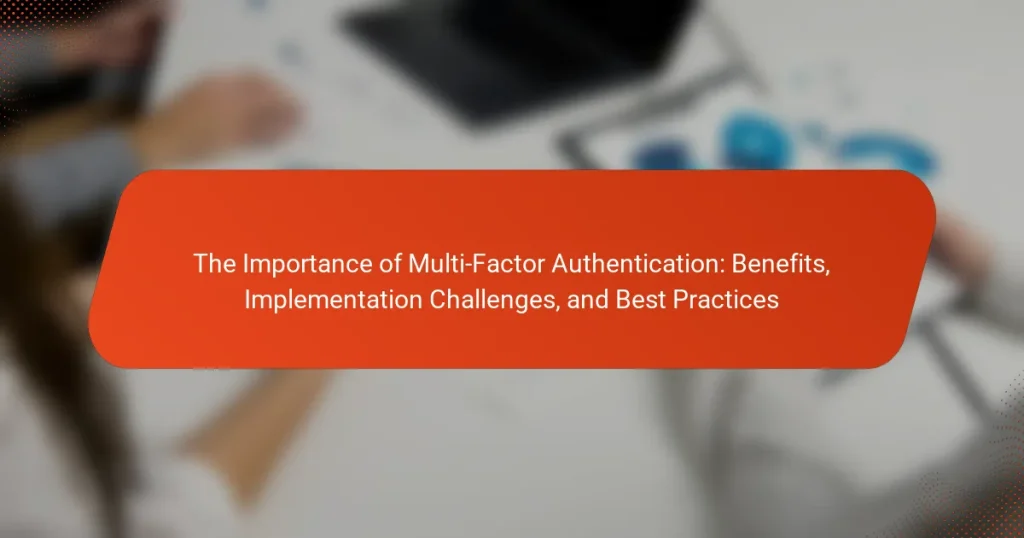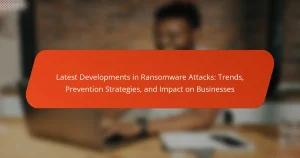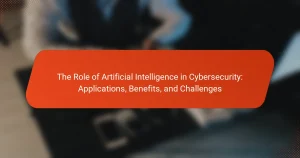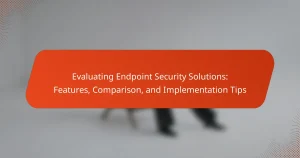Multi-Factor Authentication (MFA) is a vital security process that enhances account protection by requiring multiple forms of verification, such as a password and a mobile device. This method significantly reduces the risk of unauthorized access and data breaches, as evidenced by studies indicating that MFA can block over 99.9% of automated attacks. Despite its benefits, organizations face challenges in implementing MFA, including user resistance, technical integration issues, and associated costs. Best practices for maximizing security with MFA include using unique passwords, opting for authentication apps over SMS, and educating users about potential phishing threats. This article delves into the importance of MFA, its benefits, implementation challenges, and effective strategies for organizations.
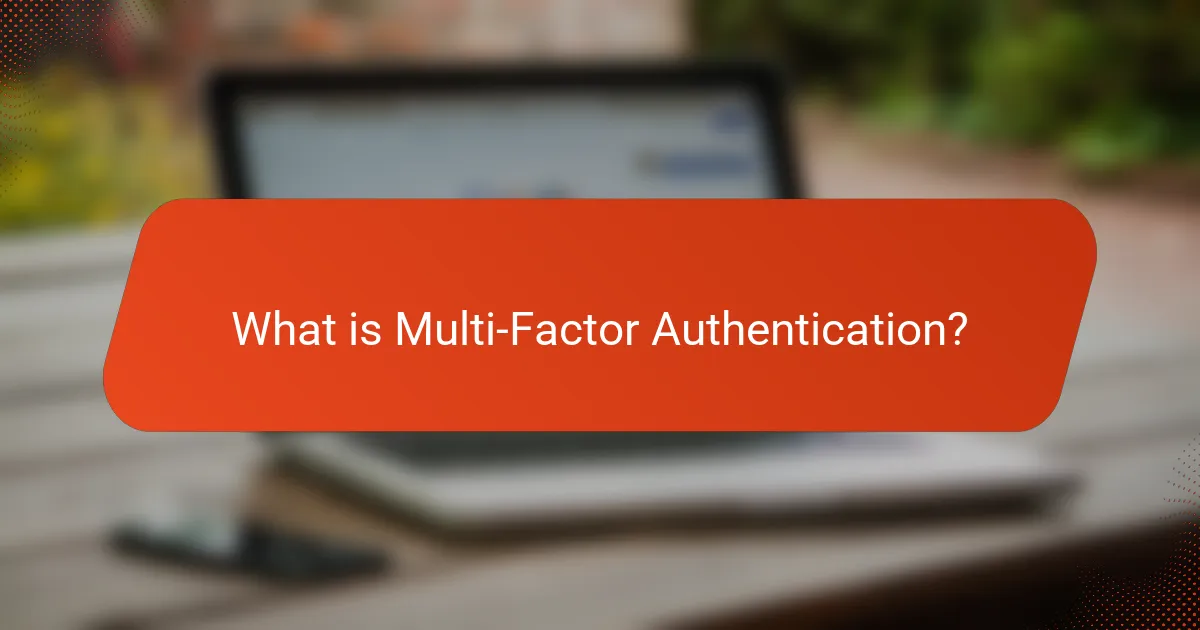
What is Multi-Factor Authentication?
Multi-Factor Authentication (MFA) is a security process that requires multiple forms of verification to access an account. It typically combines something the user knows, like a password, with something the user has, such as a mobile device. This method significantly enhances security by adding layers of protection. According to the Cybersecurity & Infrastructure Security Agency, MFA can prevent unauthorized access even if a password is compromised. Implementing MFA reduces the risk of data breaches and identity theft. Many organizations now mandate MFA for sensitive systems to safeguard against cyber threats.
How does Multi-Factor Authentication enhance security?
Multi-Factor Authentication (MFA) enhances security by requiring multiple forms of verification before granting access. This process significantly reduces the risk of unauthorized access. Traditional passwords can be compromised, but MFA adds layers of protection. Users must provide something they know, like a password, and something they have, like a mobile device for a verification code. According to the Cybersecurity & Infrastructure Security Agency, MFA can block up to 99.9% of automated attacks. Implementing MFA makes it much harder for attackers to gain access, even if they have stolen a password. This increased complexity in the authentication process is essential for safeguarding sensitive information.
What are the key components of Multi-Factor Authentication?
The key components of Multi-Factor Authentication (MFA) are something you can identify clearly. MFA requires two or more verification factors to gain access to a resource. These factors typically include something you know, something you have, and something you are.
The first component, something you know, often refers to passwords or PINs. The second component, something you have, can include hardware tokens or mobile devices. The third component, something you are, involves biometric verification like fingerprints or [censured] recognition.
Research indicates that MFA can significantly reduce the risk of unauthorized access. According to a study by Microsoft, MFA can block over 99.9% of account compromise attacks. Thus, these components are crucial for enhancing security.
How do these components work together to protect user accounts?
Multi-factor authentication (MFA) components work together by requiring multiple forms of verification to access user accounts. This typically includes something the user knows, like a password, and something the user has, like a smartphone or hardware token. By combining these elements, MFA significantly reduces the risk of unauthorized access. If one component is compromised, the additional layers still protect the account. For instance, even if a password is stolen, an attacker would still need the second factor to gain access. According to a report by Microsoft, MFA can block over 99.9% of account compromise attacks. Therefore, the integration of these components creates a robust security framework for user accounts.
Why is Multi-Factor Authentication important in today’s digital landscape?
Multi-Factor Authentication (MFA) is crucial in today’s digital landscape due to its ability to enhance security. It requires users to provide multiple forms of verification before accessing accounts. This significantly reduces the risk of unauthorized access. According to a report by Microsoft, MFA can block 99.9% of automated attacks. In an era where data breaches are rampant, MFA acts as a vital barrier against cyber threats. Organizations adopting MFA can protect sensitive information more effectively. The implementation of MFA is increasingly recognized as a best practice in cybersecurity. As cybercriminals evolve, MFA remains a key strategy in safeguarding digital assets.
What statistics highlight the need for Multi-Factor Authentication?
Multi-Factor Authentication (MFA) significantly reduces the risk of unauthorized access. According to a 2021 report by Microsoft, MFA can block 99.9% of automated attacks. The Verizon Data Breach Investigations Report states that 81% of data breaches are linked to weak or stolen passwords. A study by Google found that accounts protected by MFA are 50 times less likely to be compromised. Furthermore, the Cybersecurity & Infrastructure Security Agency emphasizes that MFA is a critical layer of security against phishing attacks. The increasing prevalence of cyber threats underlines the necessity for MFA in protecting sensitive information.
How does Multi-Factor Authentication mitigate risks of data breaches?
Multi-Factor Authentication (MFA) mitigates risks of data breaches by requiring multiple forms of verification for access. This process adds layers of security beyond just a password. Even if a password is compromised, unauthorized access is still prevented. MFA typically combines something the user knows (like a password) with something the user has (like a smartphone for a one-time code). According to a report by the Cybersecurity & Infrastructure Security Agency, MFA can block over 99% of automated attacks. This statistic highlights the effectiveness of MFA in protecting sensitive data. By implementing MFA, organizations significantly reduce the likelihood of unauthorized access and data breaches.
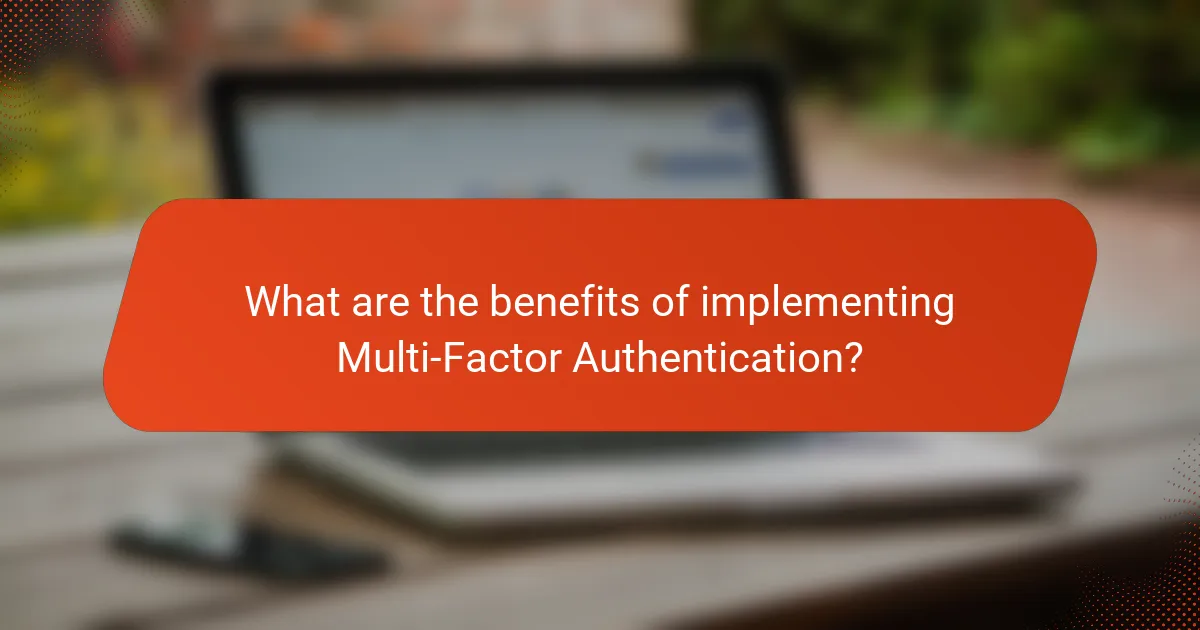
What are the benefits of implementing Multi-Factor Authentication?
Implementing Multi-Factor Authentication (MFA) significantly enhances security. MFA requires users to provide two or more verification factors to gain access. This process reduces the risk of unauthorized access due to compromised passwords. According to a study by Microsoft, MFA can block over 99.9% of automated attacks. It also adds an additional layer of protection for sensitive data and accounts. Users are less likely to fall victim to phishing attacks when MFA is in place. Furthermore, MFA can improve compliance with regulatory standards requiring strong authentication methods. Overall, MFA is a crucial step in safeguarding digital assets.
How does Multi-Factor Authentication improve user trust?
Multi-Factor Authentication (MFA) improves user trust by adding layers of security to the authentication process. It requires users to provide multiple forms of verification before accessing their accounts. This reduces the likelihood of unauthorized access, making users feel safer. According to a report by Microsoft, MFA can block 99.9% of automated attacks. The presence of MFA signals to users that their security is a priority. This proactive approach fosters confidence in the system’s ability to protect personal information. Users are more likely to trust platforms that utilize MFA due to its effectiveness in preventing breaches. Overall, MFA enhances the perception of security among users.
What impact does Multi-Factor Authentication have on customer retention?
Multi-Factor Authentication (MFA) positively impacts customer retention. It enhances security, which builds customer trust. Customers are more likely to stay with businesses that protect their data. A study by Google found that MFA can block 99.9% of automated attacks. This level of security reduces the risk of data breaches. Consequently, customers feel safer using services that implement MFA. Increased trust leads to higher customer loyalty and retention rates. Businesses that prioritize security measures like MFA often see improved customer satisfaction.
How can Multi-Factor Authentication enhance compliance with regulations?
Multi-Factor Authentication (MFA) enhances compliance with regulations by adding layers of security to user authentication processes. This increased security helps organizations meet stringent data protection standards set by regulations like GDPR and HIPAA. MFA requires users to provide multiple forms of verification, reducing the risk of unauthorized access. According to a report by the Ponemon Institute, organizations that implement MFA can reduce the likelihood of a data breach by up to 99.9%. This significant reduction supports compliance by protecting sensitive information and maintaining data integrity. Furthermore, regulatory bodies often mandate strong authentication measures, making MFA a critical component of compliance strategies.
What are the cost benefits of using Multi-Factor Authentication?
Multi-Factor Authentication (MFA) reduces costs associated with data breaches. Implementing MFA can lower the likelihood of unauthorized access. This leads to fewer incidents of data theft and associated recovery costs. According to the 2020 Cost of a Data Breach Report by IBM, organizations with MFA experienced data breach costs that were 25% lower than those without it. MFA also minimizes the need for extensive password reset processes, saving IT resources. Additionally, organizations can benefit from reduced insurance premiums due to enhanced security measures. Overall, MFA provides significant financial advantages by mitigating risks and lowering potential losses.
How does Multi-Factor Authentication reduce the costs associated with data breaches?
Multi-Factor Authentication (MFA) reduces the costs associated with data breaches by significantly enhancing security measures. MFA requires users to provide two or more verification factors to gain access to a system. This additional layer makes unauthorized access more difficult. As a result, the likelihood of a successful data breach decreases. According to a study by the Ponemon Institute, organizations implementing MFA can reduce the average cost of a data breach by approximately $1.2 million. This reduction occurs because fewer breaches lead to lower recovery costs, legal fees, and regulatory fines. Overall, MFA acts as a proactive measure, minimizing the financial impact of potential security incidents.
What return on investment can organizations expect from implementing Multi-Factor Authentication?
Organizations can expect a significant return on investment from implementing Multi-Factor Authentication (MFA). Studies indicate that MFA can reduce the risk of data breaches by up to 99%. The average cost of a data breach is approximately $4.24 million, according to IBM’s Cost of a Data Breach Report 2021. By preventing breaches, MFA can save organizations substantial amounts of money. Additionally, MFA enhances user trust and compliance with regulations, which can lead to increased customer retention and satisfaction. The initial costs of implementing MFA are often outweighed by the long-term savings and benefits it provides.
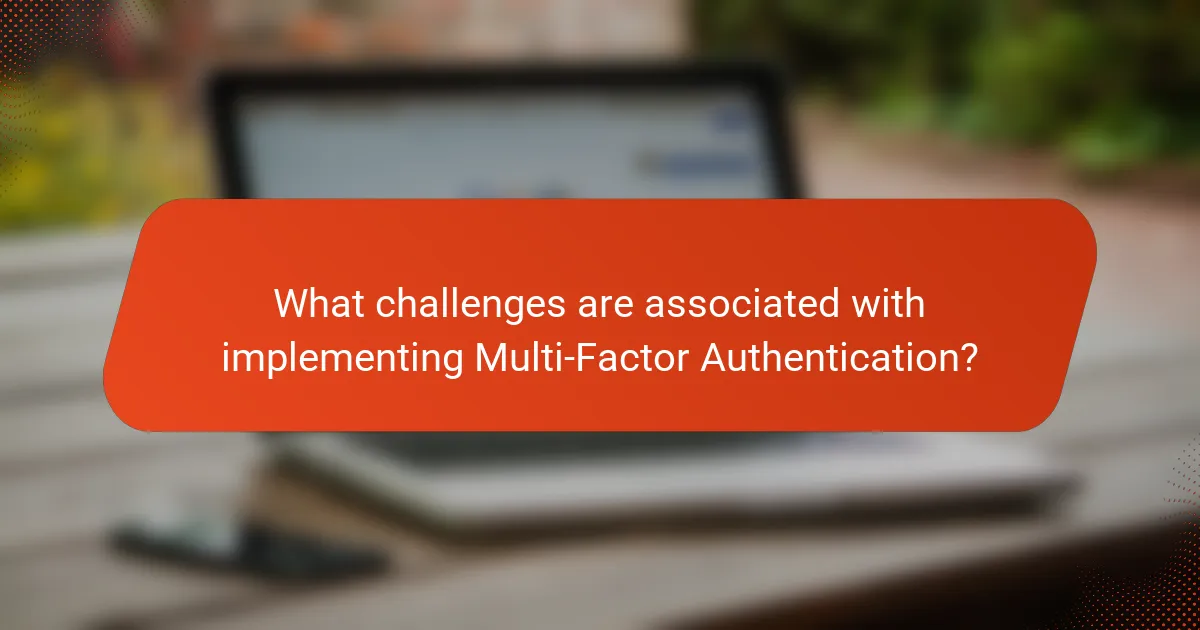
What challenges are associated with implementing Multi-Factor Authentication?
Implementing Multi-Factor Authentication (MFA) presents several challenges. User resistance is common due to perceived inconvenience. Many users find additional authentication steps cumbersome. This can lead to decreased user satisfaction and potential abandonment of services. Technical integration can also pose difficulties. Existing systems may not support MFA without significant modifications. Additionally, there are costs associated with implementing MFA solutions. Organizations must invest in new technologies and training. Security concerns arise if MFA methods are not properly managed. Poorly implemented MFA can create vulnerabilities. Finally, maintaining user education is essential. Users must understand MFA to use it effectively.
What are the common obstacles organizations face when adopting Multi-Factor Authentication?
Organizations face several common obstacles when adopting Multi-Factor Authentication (MFA). One major challenge is user resistance due to perceived inconvenience. Many users find additional authentication steps cumbersome and may resist adopting new processes. Another obstacle is integration with existing systems. Organizations often struggle to incorporate MFA seamlessly with their current infrastructure.
Cost is also a significant barrier. Implementing MFA can involve expenses for software, hardware, and training. Limited technical expertise within the organization can hinder successful deployment. Organizations may not have personnel with the necessary skills to manage MFA systems effectively.
Compliance with regulations can be complex as well. Organizations must ensure that their MFA solutions meet specific legal and industry standards. Finally, maintaining user education and awareness is crucial. Users need ongoing training to understand MFA’s importance and how to use it correctly.
How can user resistance impact the implementation process?
User resistance can significantly hinder the implementation process of multi-factor authentication (MFA). When users are reluctant to adopt MFA, it can lead to lower compliance rates. This non-compliance can result in security vulnerabilities, as not all accounts would be adequately protected. Additionally, resistance may stem from concerns about usability or perceived inconvenience. Such resistance can prolong the implementation timeline. It can also increase the costs associated with training and support. Ultimately, user resistance can compromise the overall effectiveness of the MFA system. Research indicates that successful implementation requires addressing user concerns to foster acceptance.
What technical issues may arise during the integration of Multi-Factor Authentication?
Technical issues during the integration of Multi-Factor Authentication (MFA) include compatibility problems with existing systems. Legacy systems may not support MFA protocols, leading to integration challenges. Additionally, user experience can be negatively impacted if MFA processes are cumbersome or confusing. Network latency may also cause delays in authentication, frustrating users. Furthermore, issues may arise from the management of multiple authentication methods, complicating user access. Security vulnerabilities can occur if MFA is not properly configured, exposing systems to risks. Lastly, inadequate training for users and administrators can result in improper implementation, undermining the effectiveness of MFA.
How can organizations overcome these challenges?
Organizations can overcome challenges in implementing multi-factor authentication (MFA) by adopting a strategic approach. They should begin by conducting a thorough assessment of their current security infrastructure. This assessment helps identify vulnerabilities that MFA can address effectively.
Next, organizations should prioritize user education and training. Educating employees about the importance of MFA increases compliance and reduces resistance to change. Clear communication about the benefits of MFA can enhance user acceptance.
Additionally, organizations can implement phased rollouts of MFA. Gradually introducing MFA allows users to adapt to the new system without overwhelming them. This approach also enables organizations to troubleshoot issues in real-time.
Furthermore, organizations should select user-friendly MFA solutions. Solutions that integrate seamlessly with existing systems are more likely to be adopted successfully. User experience plays a critical role in the effectiveness of MFA.
Finally, organizations must establish ongoing support and feedback mechanisms. Providing resources for users to address concerns fosters a culture of security awareness. Regularly reviewing and updating MFA strategies ensures they remain effective against evolving threats.
What strategies can be employed to educate users about Multi-Factor Authentication?
Effective strategies to educate users about Multi-Factor Authentication (MFA) include interactive training sessions, clear documentation, and real-world examples. Interactive training sessions engage users and provide hands-on experience with MFA tools. Clear documentation outlines the steps for setting up and using MFA, ensuring users understand the process. Real-world examples illustrate the potential risks of not using MFA, highlighting its importance. Additionally, visual aids like infographics can simplify complex concepts related to MFA. Regular reminders and updates about MFA best practices keep users informed and vigilant. These strategies collectively enhance user understanding and encourage the adoption of MFA.
How can organizations streamline the implementation process?
Organizations can streamline the implementation process by adopting a structured approach. This includes defining clear objectives and timelines. Establishing a project team with defined roles enhances accountability. Utilizing automation tools can simplify repetitive tasks. Conducting regular training ensures that all team members are informed. Gathering feedback during the implementation helps identify areas for improvement. According to a study by the Project Management Institute, organizations that follow structured methodologies see a 20% increase in project success rates.
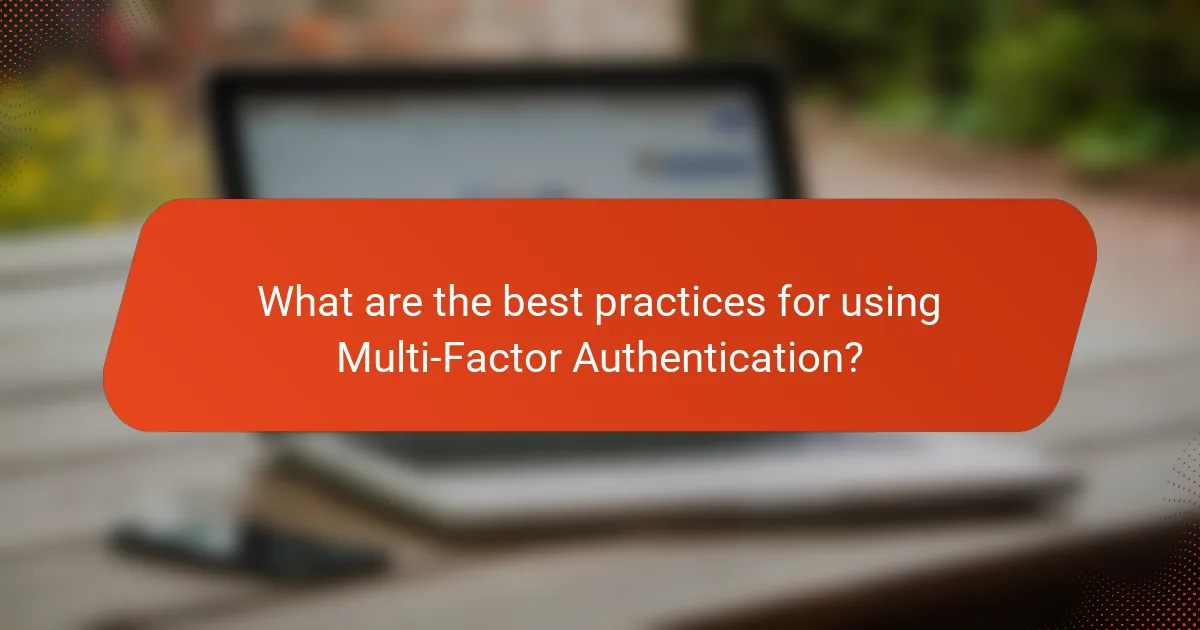
What are the best practices for using Multi-Factor Authentication?
Use unique and strong passwords for each account. This reduces the risk of unauthorized access. Implement authentication apps instead of SMS for better security. Authentication apps provide time-based codes that are less susceptible to interception. Regularly update your authentication methods to stay ahead of potential threats. Keeping software and firmware updated helps protect against vulnerabilities. Educate users about phishing attacks that target multi-factor authentication. Awareness can prevent attackers from gaining access through social engineering. Finally, enable multi-factor authentication on all accounts that support it. This maximizes security across all platforms.
What types of Multi-Factor Authentication methods are most effective?
The most effective types of Multi-Factor Authentication (MFA) methods include SMS-based verification, authenticator apps, and hardware tokens. SMS-based verification sends a code to the user’s mobile device. This method is widely used due to its accessibility. However, it is vulnerable to SIM swapping attacks. Authenticator apps generate time-based codes on the user’s device. They provide an additional layer of security and are less susceptible to interception. Hardware tokens, such as YubiKey, require physical possession of the device. They offer strong security, as they cannot be easily duplicated or intercepted. According to a study by Microsoft, MFA can block over 99.9% of automated attacks. This statistic highlights the effectiveness of implementing these MFA methods in enhancing security.
How do different methods compare in terms of security and user experience?
Different methods of authentication vary significantly in security and user experience. For instance, SMS-based authentication offers moderate security but can be vulnerable to interception. Users often find SMS convenient due to its simplicity.
On the other hand, authenticator apps provide stronger security through time-based one-time passwords (TOTP). This method requires users to install an app, which may slightly complicate the user experience.
Biometric authentication, such as fingerprint or [censured] recognition, offers high security and a seamless user experience. However, it may raise privacy concerns for some users.
Hardware tokens deliver robust security but can be less user-friendly due to the need for physical devices.
In summary, while stronger security methods may introduce some user friction, balancing both factors is essential for effective multi-factor authentication.
What factors should organizations consider when choosing a Multi-Factor Authentication method?
Organizations should consider usability, security strength, cost, and integration capabilities when choosing a Multi-Factor Authentication (MFA) method. Usability affects user adoption and satisfaction. A method that is too complicated may lead to frustration. Security strength is vital; stronger methods provide better protection against unauthorized access. Cost considerations include not only initial setup but also ongoing maintenance expenses. Integration capabilities with existing systems are crucial for seamless implementation. A method that easily integrates reduces operational disruptions. Organizations should also assess compliance with industry regulations. This ensures that the chosen MFA method meets legal and security standards.
How can organizations ensure ongoing effectiveness of Multi-Factor Authentication?
Organizations can ensure ongoing effectiveness of Multi-Factor Authentication (MFA) by regularly updating authentication methods and protocols. Regularly reviewing and updating security policies is essential. Organizations should conduct periodic security audits to identify vulnerabilities. Employee training on the importance of MFA enhances compliance and effectiveness. Implementing adaptive authentication can improve security based on risk levels. Monitoring authentication logs helps detect suspicious activities promptly. Additionally, integrating user feedback can refine the MFA process. Research indicates that organizations using multi-layered security strategies reduce breaches by up to 80%.
What role does regular review and updates play in Multi-Factor Authentication security?
Regular review and updates are crucial for Multi-Factor Authentication (MFA) security. They help identify and mitigate emerging threats. Cybersecurity is constantly evolving, with new vulnerabilities appearing regularly. Regular updates ensure that MFA systems incorporate the latest security protocols. This practice also helps maintain compliance with industry standards and regulations. For instance, the National Institute of Standards and Technology (NIST) recommends periodic assessments of authentication mechanisms. By reviewing and updating MFA, organizations can enhance their overall security posture. This proactive approach reduces the risk of unauthorized access and data breaches.
How can organizations monitor and respond to potential vulnerabilities in Multi-Factor Authentication systems?
Organizations can monitor and respond to potential vulnerabilities in Multi-Factor Authentication (MFA) systems by implementing continuous security assessments. Regular vulnerability scans can identify weaknesses in MFA configurations. Organizations should also analyze authentication logs for unusual access patterns. Setting up alerts for multiple failed authentication attempts can indicate potential attacks.
Conducting [censured] testing can reveal exploitable vulnerabilities in the MFA setup. Training employees on recognizing phishing attempts can help mitigate risks. Implementing adaptive authentication can enhance security by adjusting requirements based on user behavior. Finally, maintaining up-to-date software and security patches is crucial to protect against known vulnerabilities.
What practical tips can organizations follow for successful Multi-Factor Authentication implementation?
Organizations should prioritize user education and training for successful Multi-Factor Authentication (MFA) implementation. This ensures users understand the importance of MFA and how to use it effectively. Organizations must select the right MFA methods that align with user needs and security requirements. Common methods include SMS codes, authentication apps, and biometric verification.
Regularly testing the MFA system is essential to identify vulnerabilities. Organizations should also create a backup authentication method for users who may face issues with primary methods. Clear communication about MFA processes helps reduce user frustration. Additionally, organizations must monitor and analyze MFA usage to adapt to evolving security threats. Implementing these strategies can significantly enhance the effectiveness of MFA in protecting sensitive information.
Multi-Factor Authentication (MFA) is a critical security process that requires multiple forms of verification to access accounts, significantly enhancing protection against unauthorized access and data breaches. The article covers the key components of MFA, including various verification factors such as passwords, mobile devices, and biometric data, and emphasizes its importance in today’s digital landscape. It highlights the benefits of implementing MFA, including improved security, user trust, compliance with regulations, and cost savings, while also addressing the challenges organizations face during implementation. Best practices for successful MFA adoption and ongoing effectiveness are outlined, ensuring that organizations can safeguard sensitive information against evolving cyber threats.
